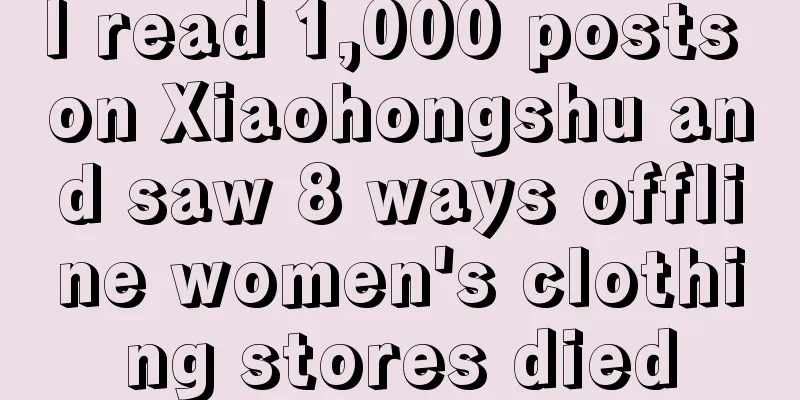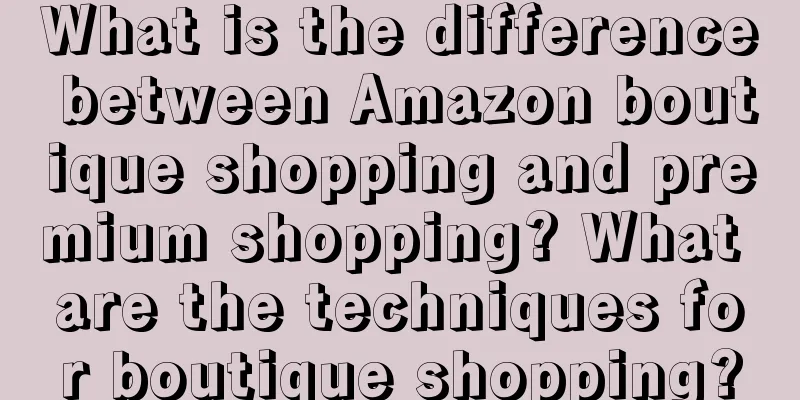I read 1,000 posts on Xiaohongshu and saw 8 ways offline women's clothing stores died

Because I’m engaged in the women’s clothing category of e-commerce, I also pay a lot of attention to the offline women’s clothing business. However, I didn’t pay much attention to major offline women’s clothing brands such as Uniqlo and Gedi. My focus is on individual offline women's clothing stores and the owners behind them. After reading a large number of entrepreneurial posts by women's clothing store owners on Xiaohongshu, I suddenly felt that it was difficult to run an e-commerce women's clothing business, and it would be even more difficult to run an offline women's clothing store. If women's clothing e-commerce is compared to purgatory or hell, then at least after going through some trials and tribulations, capable people can still stand out; But I think offline women's clothing is definitely in death mode. The moment many ordinary people decide to open an offline women's clothing store, they have already stepped half a foot into death. Because there are too many uncontrollable factors, problems may occur in any link, and any problem may cause the store to go bankrupt. And I observed these shop owners and felt that many of them had no experience in starting a business or opening a shop, or in the women's clothing industry. Therefore, many low-level mistakes will be made, but in fact many mistakes and problems can be effectively avoided at the beginning. So I couldn’t hold back and wrote this article today. To sum up, individual women's clothing store owners may encounter a series of problems in various modules during the entrepreneurial process. In order to take care of the reading experience, this article will be divided into two parts [Part 1] and [Part 2]. 1. The first module: product sideLet’s start with the product side. If you open a women’s clothing store and sell women’s clothing, the products must first pass the test. If you open a store and the clothes don’t look good, who will buy your products? I read some posts about store closures and was not too surprised. It cannot be blamed on the bad economy or the bad environment. It is just that the clothes are ugly, ordinary, and cheap. There is no desire to buy them. The shop owners of some posts seemed to be hit hard, and they kept asking everyone in the comment section: Sisters, are the clothes I sell good looking? Sisters, are the clothes I sell good looking? This reflects a very important issue: Many clothing store owners think they have aesthetic taste. But it’s a pity that this aesthetic has not been verified by the market. We always talk about aesthetics. Aesthetics is a very subjective thing. Everyone thinks that his or her aesthetics is OK. After all, no one will admit that his or her aesthetics is LOW. If you don't engage in commercial activities and don't do the women's clothing business which is very dependent on aesthetics, then there is nothing to be afraid of. Just do whatever you think is good. But once you really start selling women's clothing, your aesthetics will have to be tested by the market. Only aesthetics that can pass the test of the market can truly stand the test. In addition to the styles not looking good, some of the styles selected by the store owners create a vague style. In other words, I don’t know what style I’m selling or what kind of people I want to sell to. If you say it's casual, it's also a little spicy; if you say it's a little spicy, it's also a little ladylike; if you say it's somewhat youthful, some styles are still relatively old-fashioned; if you say it's more Korean, it's also somewhat French; if you say it's somewhat French, it's also somewhat street style. For women's clothing, style confusion is a serious problem. Because once consumers enter your store, if they don’t understand your style, they will immediately tell that this is not their store and quickly leave. Moreover, once your style is messed up, it will be hard to match products together. Casual items cannot be matched with gentle items, and trendy items cannot be matched with everyday items. It is difficult to sell products together, and if you force the combination, the effect will not be good. Maybe some shop owners incorporate their personal dressing habits into the selection of styles for their clothing stores. When we dress, we do have some variety and we pursue different styles. But when selling clothing, an extremely unified style is very important. Only in this way can you quickly convey your product ideas to consumers, give them a fashionable impact, and attract precise users. The style of your store is messy, just like a grocery store. Who would be attracted to it? When opening a women's clothing store offline, the proprietress not only has to be a salesperson, but also has to act as a model. She has to dress up, take pictures, shoot videos, and encourage customers. If the store owner and the style she chooses can be well integrated, it will have a good effect of planting grass. But after reading some of the shop owner's posts, I can feel that the boss lady and her styles cannot be well integrated together, and it feels like the shop owner is forcing the style. Not only did this fail to attract buyers, but it completely made people lose the desire to buy. To avoid personal attacks, I will not post the illustrations here. Maybe compared to women's clothing on e-commerce platforms, Offline women's clothing stores, on the contrary, have higher requirements on the store owner's appearance, figure, and temperament, because they have to act as models and promote customers. I have indeed seen some offline stores that are doing well. The boss ladies are all very beautiful and they are very attractive when they wear clothes. If the store owner cannot integrate well with the clothes she sells, many conversion points will not be achieved. Different from online, the offline fashion standards are more stringent than online. You can sell basic items, ordinary items, and everyday items online. As long as you keep the prices low, promote them properly, and provide slightly better pictures, you will eventually be able to sell them. But in small offline women's clothing stores, I don't think basic or ordinary styles can survive. Consumers will not go to offline stores to buy ordinary clothes. If your product is too ordinary, with a bad style and fabric, and in actual offline scenarios, the clothes have no luster and texture, it will be difficult to attract customers. But at the same time, your offline store cannot be too fashionable. For example, when I look at some posts, the shop owners may choose more advanced and niche styles in order to show their fashion aesthetics. Instead, it makes consumers feel that they cannot wear it, cannot control it, and lose the possibility of buying it. Therefore, offline stores need to be more precise in their grasp of fashion. If you can’t sell ordinary basic styles, they will occupy your shelves and you won’t be able to sell them at a high price. It will be difficult to sell items that are too advanced, fashionable, or niche. Therefore, your grasp of aesthetics and fashion must be close to consumers, but also a little bit higher than consumers. Let her feel that your styles are fashionable, but at the same time I can wear them. This level of mastery is very demanding for many store owners, requiring several years of experience and constant training through market feedback; But many shop owners have not experienced such training, and their products may appear too ordinary or too niche. By the time she figured it out, her money was all gone and the store had closed down. Finally, we have to mention the issue of matching; When there are problems with product style, selection, and fashion, it will inevitably have a direct impact on matching. The most intuitive manifestation is that the combination is ugly and weird. The clothes were ugly to begin with, and with the weird combination, they became a complete disaster. Secondly, there are limited styles that can be matched together. If you give a customer one set of matching clothes and the customer is not satisfied, it will be difficult for you to try a second or third set of matching clothes. The clothing store owner who has good selection, good positioning and unified style has a very high success rate of matching goods with goods. One piece can be matched with multiple pieces, and multiple pieces can be matched with multiple pieces. The store owner who has poor selection of styles can only sell individual pieces of clothing and not sets, and the sales volume difference is many times. I've seen many posts about store closures discussing issues like lack of traffic, lack of customer base, and how to generate traffic. But in fact, for many stores, it is difficult to attract traffic to their products even if you give them traffic. I saw a shop owner who was poor at selecting and matching products. He was live streaming every day for more than ten hours. It can be said that he was working hard, but it was difficult to sell that product no matter how much he promoted it. Therefore, for offline women's clothing stores, products come first. Only when you have good products can you expand into Xiaohongshu, live streaming, WeChat and other traffic-generating methods. There are some product issues that I will not elaborate on due to space constraints, such as color. A good store will give you a sunny and warm feeling, which looks very comfortable. I have also given some examples in the figure below, which are stores that I think have good selection, matching, and color. At least you can quickly and clearly perceive what style this store sells and what kind of people it is suitable for. 2. The second module: procurementMany clothing store owners are basically in second-, third- and fourth-tier cities, so it is more troublesome to purchase goods and find sources. First, you need to purchase goods from clothing wholesale markets, such as Guangzhou, Hangzhou, Jiaxing, Wuhan, Shenzhen, etc. You have to take the high-speed rail, fly, and travel a lot. Then the style, emphasis, price, and texture of clothing wholesale markets in various places are all different. Many shop owners don’t know much about these places in the early stage. Which are the high-quality suppliers and which suppliers have the highest cost performance ratio? Which suppliers specialize in what styles and categories? Which suppliers are the source and which suppliers are middlemen; In the early stages, you need to spend time exploring and groping, and you will encounter some pitfalls. Moreover, since the time available each time is limited, many shop owners hope to save on accommodation and travel expenses, so they select styles quickly and make purchases more impulsively. These wholesale markets are crowded with people, and the air is filled with a sense of anxiety, which can easily make people get drunk. Many new shop owners may have budget control at the beginning, but when they get impulsive, they can't stop themselves and buy whatever clothes they see. Because of offline purchase, the minimum order is 5 pieces for one style and one pattern, so you need to buy 5 pieces. Many new shop owners think that 5 pieces are just 5 pieces, they can all be sold anyway. But I couldn't help but pick out dozens of styles at once, and bought 5 pieces of each style, which meant hundreds of pieces in total, and tens of thousands of dollars were invested in the goods. Logically speaking, tens of thousands of yuan may not seem like a lot of money. But many shop owners first paid tens of thousands of yuan in rent (3% deposit and 3% payment), Then I spent tens of thousands of dollars on renovations. In the end, the remaining funds were basically used to purchase goods, and there was no liquid capital on hand. It would be fine if all the goods we imported were sold. But most people, because they have no experience at the beginning, basically have nothing in their hands after the first batch of goods, and cannot sell them, and cannot recover the funds. Direct bankruptcy. I have seen many posts mentioning that novices cannot control themselves when purchasing goods in the early stage, and they buy a lot at once, spend all their money, and then are unable to make ends meet. Those who bought 120,000 yuan in their first purchase, like the one in the picture below, are even more stubborn. This process actually causes great frustration to many store owners. Because going to the market to choose is very hard and tiring. You have to go around, choose everywhere, and chat everywhere. At night, you have to match and try on styles when you return to the hotel. You are full of energy, and the money is spent. In the end, I didn’t sell much when I got back, which was like a critical blow from real life. This kind of purchasing training and experience accumulation may require a novice store owner to go through a lot of practice before becoming experienced, but many people can no longer hold on to that moment. 3. The third module: OperationsThis operation does not involve traffic for the time being, we will talk about traffic later. After reading some posts from shop owners who have closed their shops, I found a common problem: These shop owners are not very good at taking pictures. I can’t take pictures of clothes, and I can’t take visual pictures of clothing. Many shop owners may not realize that one of the core skills required to open a women's clothing store is [photography]. The women's clothing business has actually always been closely related to the photography industry. Because whether you post pictures on your Moments, or take a picture of your upper body and post it on Xiaohongshu or Tik Tok, You have to take good pictures of your clothes and selfies in the mirror. This includes shooting some outfit videos, entrepreneurship videos, and clothing videos, which are essentially extensions of photography. Many store owners cannot take good pictures, and they basically lose the ability to attract traffic from online channels. No traffic, no sales, no store visits, If the offline customer flow is low, it will be closed directly. For example, the pictures below are all taken very strangely. Compared to some experienced shop owners, who may have had experience in clothing stores and photography before, So when they open a clothing store, they will decorate the store in advance to create a scene suitable for taking photos. Or you can change the lighting and atmosphere of the entire decoration to create a scene suitable for taking fashion photos or videos of outfits. Even if you don't wear the clothes, just put them on the rack and take a photo, they will look good. These are all very experienced shop owners. The pictures below are some examples I have selected. Only if you take good photos of the clothes can you attract customers! Another is sales ability. After reading many posts, I feel that most store owners are actually unable to convert customers who just come in to take a look. There is no process or action in this regard. For example, when a customer comes in, you can greet them first, then pour them a glass of water or a drink. Invite them to sit down, say hello and chat, and guide them step by step through the process of trying on clothes. The mentality displayed by most shop owners is that after customers enter the store, the shop owners just sit there, do not disturb them, and then watch the customers leave. So how can there be transformation? For example, when we look at data from e-commerce, even if customers do not buy, at least we can judge whether they are interested through clicks, add-to-cart, favorites, and retention time. Then it is more important for offline stores to explore customer needs. Even if you receive a customer and he or she doesn't buy, through communication and trying on the products, at least you can know where the problem with your product lies and make adjustments accordingly. But most store owners don’t actually have a complete reception process for customers from the moment they enter the store to being greeted to completing the trial. This means a wasted opportunity to tap into customer needs. There are still some operational issues in offline women's clothing stores that are very troublesome. For example, it is difficult to clear the goods. Many shop owners are inexperienced in the early stage. After purchasing goods twice, a large amount of inventory is accumulated. At this time, you need to start clearing out the stock urgently, but the store is relatively small. If you put a clearance sale on the clothes, it will inevitably affect your new styles. For example, many shop owners underestimate the loneliness of running a shop before starting their own business. When you open a store offline, you can’t just work for three days and rest for two days. You have to keep the store open whether there are people or not. Oftentimes, there are no customers in the store, and you can only sit there and watch the unsold goods become more and more worried. This will not be a good psychological state in the long run. These are issues that many people don't realize before opening a clothing store. |
<<: What is more difficult than doing private domain business is recruiting private domain talents.
>>: Watch a drama, and your loved ones and friends have to pay extra
Recommend
How do I sign up for Wish? What are the requirements for registration?
Wish is a leading global e-commerce platform that ...
Xiaohongshu is easy to defend but difficult to attack
It is reported that Xiaohongshu has completed a ne...
6 recent experiences in operating Xiaohongshu, what is grass-planting? How can restaurants operate Xiaohongshu?
Recently, while operating Xiaohongshu, I found som...
Franchise loss revelation: 10 million yuan to open 21 convenience stores, became the most regrettable investment
Text | Zhai Yuanyuan The last Carrefour supermarke...
From business transformation to consumer change, let’s talk about brand reshaping
Branding is about connecting a brand with a target...
How to open a local store on Shopee in Thailand? Introduction to the registration process
Merchants who want to enter Shopee can open cross-...
Who is the owner of the vova cross-border e-commerce platform? How is this platform?
In the field of cross-border e-commerce, vova, as ...
Internet celebrity soda, pour it before the hot summer comes
Exploring the rise and fall of the internet-famous...
Does shein need an overseas warehouse to open a store? What is shein?
More and more merchants are opening stores on shei...
Where is the entrance to Amazon North America? How to operate after opening?
As one of the world's largest e-commerce compa...
What happens if Shopee delays delivery? How to reduce the delay rate?
The delayed delivery rate refers to the failure of...
Xiaohongshu releases the most stringent traffic management rules
Recently, Xiaohongshu released its most stringent ...
How does Shopee find the source of goods for cross-border e-commerce? How to run Shopee well?
Shopee, like AliExpress, is a cross-border e-comme...
Does the new Amazon store make money? How to operate it?
There are many domestic seller friends who want to...
Guanxia, a domestic niche fragrance brand, has a repurchase rate of up to 60%. How does it achieve annual revenue of over 100 million yuan solely through private domains?
A small domestic fragrance brand stands out in the...









